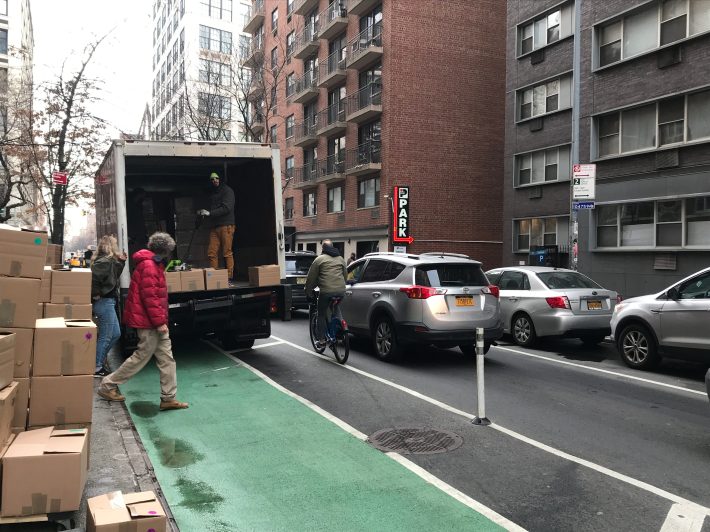They took the "protected" out of protected bike lanes!
Mayor de Blasio's much-hyped announcement Wednesday that the city had installed 20.9 miles of protected bike lanes is untrue, a Streetsblog investigation reveals.
The actual number is 16.05 miles, or 23.2 percent less.
Why the discrepancy? The city has quietly been using a definition of "protected bike lane" that allows a route to be called "protected" even if there is no physical barrier.
Cyclists have long defined the term "protected bike lane" to mean a lane which cars cannot enter or park on because drivers readily commandeer anything but strongly guarded space. The National Association of City Transportation Officials defines a protected bike lane as a lane that offers "physical protection from passing traffic" in the form of "a parking lane or other barrier between the cycle track and the motor vehicle travel lane."
In a statement, the Department of Transportation offered its definition: "A protected bike lane is a path intended for the use of bicycles that is physically separated from motorized vehicle traffic by an open space, vertical delineation, or barrier."
Cycling advocate Doug Gordon was angered by the definition.
"The city can't call a bike lane 'protected' if all that separates flesh-and-bone people on bikes from steel-and-glass cars and trucks is paint — unless that paint has some sort of magic automobile repellant," said Gordon, who tweets as Brooklyn Spoke. "A bike lane is either protected from moving traffic and parked cars or it isn't. This isn't horseshoes or hand grenades, where 'close enough' counts."

Many of the bike lanes that Mayor de Blasio heralded in his announcement on Wednesday are, indeed, protected by the NACTO definition, such as the paired lanes on 43rd Avenue and Skillman Avenue in Sunnyside, which amounted to 2.6 miles of the overall total; Broadway in The Bronx, which added 2.4 miles to the total; and the Ninth Street bike lanes in Park Slope, which registered 1.8 miles.
But at least 4.85 miles of the mayor's promised "protected bike lane" are not protected at all. They offer cyclists just green paint and a prayer. (In 2017, using the same definition as this year, the city said it created a record-breaking 24.9 miles of protected bike lanes. Chicago has at times also used the weaker definition in order to boost its miles of "protected" lanes.)
Streetsblog rode the "protected" bike lanes on 29th, 26th, 13th and 12th streets in Manhattan on Thursday and found that only 2.5 miles of the 5.9 miles of protection claimed by the mayor (and lapped up by some media outlets).
There were .3 missing miles of protection on the 29th and 26th street lanes (between Ninth and 10th avenues on W. 29th St. and between 11th and 12th avenues on W. 26th St.) and 3.1 missing miles on 12th and 13th streets (in other words, the entirety of those lanes, which do not offer physical protection for cyclists from drivers).

And on Grand Street between Union and Bushwick avenues in Brooklyn, the mayor said the city installed 1.8 miles of protected bike lanes. But that's impossible because Grand Street between Union and Bushwick avenues is only 1.1 miles long (the city has long counted each side of a street when it calculates bike lane lengths).
DOT spokesman Brian Zumhagen attributed the error to a typo in the press release, saying that the 1.8 miles actually referred to Borinquen Street/Grand Street from Rodney Place to Waterbury Street, which is indeed 1.8 miles.
But of those 1.8 miles of bike lane, only .35 are protected in the classic sense of the word, with the remaining area either not fully protected or not completed yet. The unprotected sections are often blocked.
"DOT should know that unprotected bike lanes would be blocked," said Brooklyn cycling activist Philip Leff. "This is just a mayor wanting a number that looks good rather than caring about what it's like to be someone who uses a bike for daily transportation."

Gordon said the issue is bigger than merely a numbers count of "protected bike lanes," but one of fostering the growth of cycling.
Eyes on the Street
No portion of the bike lanes on 13th and 12th streets is physically protected from automobile traffic, save for a tiny number of plastic sticks on some blocks that are placed very far apart. As a result, a number of things happen:
- Drivers enter the buffer zone or the bike lane itself, frequently. This presents a clear danger to cyclists. (See photo at the top of this story and the one below)

- Taxis pull into the lane to make pick-ups and drop offs, causing lots of arguments as cyclists (see byline on this story) yell at cabbies, who yell back. (see photo below)

- Trucks frequently park in the bike lane, forcing cyclists into traffic, as the photo below shows.

Other findings
- Some of the mayor's "protected" bike lanes are not even painted green, which seems to be the city's current definition of a painted bike lane. Here's W. 29th Street between 11th and 12th avenues:

- Some offer no protection from trucks, like W. 29th between Ninth and 10th avenues:

- And on W. 26th Street, cyclists are forced into traffic, which is the opposite of a protected bike lane.

- A lot of the work that the mayor says is done is not done. Here is Grand Street, which was labeled as completed protected bike lane on the mayor's press release.

In conclusion, is this what happens when a bike lane is truly protected?







